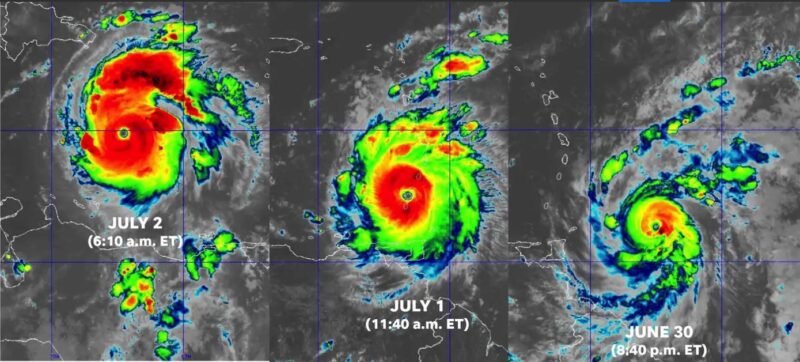
- Earth’s sea surface reached record high temperatures in 2023, making it the hottest year yet recorded for oceans.
- Scientists noticed exceptionally strong ocean heatwaves that year. They’ve now coined a new term for them: “super-marine heatwaves.”
- These super-marine heatwaves may harm ocean life and make hurricanes stronger.
2023’s record sea surface temps
2023 was a record-breaking year for heat.
According to the Annual 2023 Global Climate Report, 2023 was the warmest year since global atmospheric temperature record-keeping began in 1850. Overall, the year was 1.18 degrees Celsius (2.12 Fahrenheit) above the 20th-century average of 13.9 C (57.0 F). Now, a new analysis led by scientists at the National Centers for Environmental Information (NCEI) shows that global mean sea surface temperatures also set a record high in 2023. The study further indicates that these record-breaking temperatures were associated with extremely strong marine heatwaves.
These heatwaves were so noticeable and so different that the authors gave them the name super-marine heatwaves.
Scientists published the new study in Geophysical Research Letters.
Decades of data tell the tale of warming seas
Sea surface temperature is the temperature of the uppermost layer of seawater, typically the top few meters. Sea surface temperature data are collected via satellite observations or via in situ observations from ships, drifting buoys, moored buoys, and more recently, surface autonomous vehicles such as saildrones.
NCEI’s Daily Optimum Interpolation Sea Surface Temperature (DOISST) is a global record, tabulated daily, and including data from September 1981 onwards. It blends satellite data on sea surface temperatures with in situ data from ships, buoys, and Argo floats.
The analysis of this record shows that – globally, from latitude 90°S to 90°N – averaged daily sea surface temperatures started breaking historical seasonal record highs in March 2023. Records continued to break until early summer 2024. An all-time record high was set on April 4, 2023 (18.83 C). This record was continually broken from July 16 until August 21, 2023 (19.00 C).
Overall, the analysis showed that the sea surface temperatures in 2023 reached record highs over much of the global oceans.
The new study shows that the 2023 record-high sea surface anomaly is attributed to a long-term warming trend associated with increasing greenhouse gases, a shift to the warm phase of a multidecadal Pacific-Atlantic-Arctic mode, and a warming associated with the transition from 2020–2023 La Niña events to the 2023–2024 El Niño event.

Super-marine heatwaves: So noticeable it earned a name
Boyin Huang, NCEI Oceanographer and lead author of the paper, described why the long-term warming and the natural change in the PAA is of concern:
The impact of the first two factors suggests high sea surface temperatures into the future, particularly in the Northern Hemisphere summer.
The paper also indicates that these record-breaking sea surface temperatures were extremely strong marine heatwaves. The marine heatwaves were so powerful that the authors came up with a new term for them: super-marine heatwaves.
Marine heatwaves usually describe any time when the ocean temperature is above the 90th percentile for five or more days in a row, with gaps of less than three days. This means that the temperatures are warmer than 90% of the previous observations for a given time of year.
In 2023, Marine heatwaves were so extreme that the paper’s authors coined the term “super-MHW” to describe when the daily SST in 2023 exceeded the corresponding maximum daily sea surface temperature from the period of 1982–2022. These super-marine heatwaves occurred across the globe, including in the Arctic region.
Super-marine heatwaves and record high temps
Marine heatwaves can have significant impacts on ocean life including fisheries collapse and coral deaths. They can occur all over the world, including in the Arctic zone. The authors of the paper documented super-marine heatwaves occurring in the central tropical Pacific near the dateline (0.1 C – 0.2 C), the eastern tropical Pacific east of 120°W (0.1 C – 0.5 C), the North Pacific north of 30°N (0.2 C – 1.0 C), the northern tropical Atlantic between the equator and 30°N (0.2 C – 0.5 C), the northwestern North Atlantic south of Greenland (0.5 C), the Arctic coastal zone (0.5 C – 2.0 C), the western Indian Ocean west of 90°E (0.2 C – 1.0 C), and the Southern Ocean (0.2 C – 1.0 C). MHWs affect the biology and chemistry of an ecosystem.
There are many impacts to the Earth’s climate systems associated with the record-breaking ocean surface temperature, one of them being the increased strength and rapid intensification of hurricanes, as warm waters provide fuel to the storms.
Corresponding with the record-breaking ocean surface temperature in 2024 was the earliest Category 5 hurricane on record, Hurricane Beryl. It intensified in a very short time from a tropical storm to a Category 5 hurricane.
Bottom line: Super-marine heatwaves – extremely strong periods of hot weather at sea – played a role in 2023’s record high sea surface temperatures according to NOAA research published in July 2024.
Read more: Heatwaves: How animals adapt to cope with them











